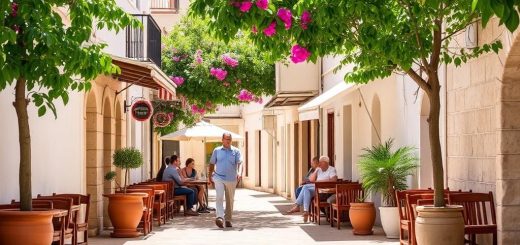Traditional Music and Dance: Cyprus Cultural Heritage
Introduction to Cyprus Music Culture
Cyprus, an island steeped in a rich and complex history, has cultivated a unique Cyprus music culture that serves as both a reflection of its diverse influences and a proud emblem of its identity. The island’s geographical position at the crossroads of Europe, Asia, and Africa has embedded layers of tradition, language, and musical style into its cultural fabric. Traditional music Cyprus involves not only sounds and instruments but also a deeply rooted social practice interwoven with dance, storytelling, and communal celebrations.
The music and dance of Cyprus transcend entertainment; they function as a language of heritage and identity for Cypriots. Over the centuries, the fusion of Greek, Ottoman, Middle Eastern, and Western European elements has created a vibrant local music scene Cyprus that continues to evolve while preserving its core traditional elements. Understanding this heritage requires examining both the musical and dance forms that define Cyprus in a comprehensive, culturally nuanced manner.
Cyprus music culture represents a living tradition where ancient melodies and rhythms narrate the island’s story, uniting past and present.
The Historical Origins of Traditional Music Cyprus
The roots of traditional music Cyprus extend back millennia, shaped by the island’s historical interactions with civilizations such as the Mycenaean Greeks, Romans, Byzantines, Venetians, and Ottomans. Each dynasty and occupation added distinctive layers to Cyprus’s cultural soundscape. Folk music Cyprus, in particular, serves as a historical archive, carrying oral histories, legends, and social memories through generations.
In the medieval and Ottoman periods, cultural music Cyprus started to formalize patterns recognizable today. Village communities played a pivotal role in maintaining musical traditions, often centered on agrarian cycles, religious ceremonies, life events such as weddings and funerals, and seasonal festivals. The traditional instruments, melodic structures, and dance forms were refined through these social contexts, becoming essential components of communal identity.
Many of the traditional songs were set to modes and rhythms akin to those found in Byzantine chant and Middle Eastern maqams, illustrating the extensive cultural interchange. The enduring popularity of these modes attests to the local music scene Cyprus’s ability to maintain ancient forms while allowing for expressive freedom and regional variations.
Key Instruments in Folk Music Cyprus
One of the defining features of Cyprus music culture is its distinctive instrumentation. A set of traditional instruments gives folk music Cyprus its characteristic timbre and flavor, each with a specific cultural and functional significance.
The laouto is a stringed instrument akin to a lute, crucial for rhythm and structure in ensembles. It produces a warm, bright sound and accompanies both singing and dance. The violi (violin) is another staple, adapted uniquely in Cyprus for expressive melodies often employing microtonal variations. Its voice is central in both solo and group performances.
Traditional wind instruments such as the flauta or local reed pipes offer soaring, sometimes haunting melodies. The tamboutsia, a form of drum, and the defi (a type of tambourine) provide essential rhythmic drive, accentuating the dance tempo and song pulses.
| Instrument | Description | Role in Music |
|---|---|---|
| Laouto | Long-necked lute with steel strings | Rhythmic foundation and harmony |
| Violi | Cypriot folk violin | Melodic lead and ornamentation |
| Flauta | Traditional reed flute | Melodic interludes and ornamentation |
| Tamboutsia | Hand drum | Rhythmic accompaniment |
| Defi | Tambourine-like percussion | Percussive rhythm and accent |
Traditional instruments in Cyprus are not merely tools but custodians of cultural memory, shaping the island’s unique sound.
Characteristics of Folk Music Cyprus
Folk music Cyprus is marked by distinct melodic and rhythmic characteristics that separate it from other Mediterranean and Eastern traditions, even though it shares some commonalities. Its melodies often employ microtonal intervals and modal scales that parallel the maqam system, providing expressive nuance and emotional depth well-suited to conveying the stories and sentiments of everyday life.
The rhythms of Cyprus folk music are equally distinctive, including complex patterns such as 9/8, 7/8, and 5/8 time signatures, which underpin various dances and rituals. These meters create a dynamic foundation for both solo instrumental pieces and ensemble performances, facilitating vibrant, energy-filled experiences.
Vocals also play a central role in Cyprus music culture. Songs are typically narrative-driven, with themes ranging from love and loss to historical events and folklore. Many are performed in a call-and-response format or feature group singing with richly ornamented lead lines supported by harmonic drones.
Traditional Dance Forms and Their Social Significance
The traditional dances of Cyprus are inextricably linked to its music and reflect the island’s social dynamics and historical phases. They are often performed in communal settings during weddings, festivals, and religious feasts, serving as social glue that reinforces community bonds.
Common dance forms include the tsamiko, zeibekiko, and the karsilama, each with unique steps, tempo, and mood, ranging from slow, contemplative movements to vigorous, celebratory patterns. These dances demand physical expression of communal values such as honor, resilience, and joy.
Group circle dances are particularly significant, where an often large number of participants grasp hands or shoulders, moving in synchrony. This symbolizes unity and continuity, embodying cultural transmission through generations. The cyclical nature of the dances often metaphorically represents the cycles of life and nature essential in Cypriot culture.
Dance in Cyprus is not only a form of artistic expression but a vital social ritual, encoding cultural values and fostering group identity.
Influence of Cultural Music Cyprus on Modern Local Music Scene Cyprus
The vitality of traditional music and dance continues to shape the evolving local music scene Cyprus. Contemporary musicians draw on folk music Cyprus motifs, instruments, and structures, often fusing them with genres such as pop, rock, jazz, and electronic music. This blend reflects the ongoing dialogue between Cyprus’s cultural past and its present urban realities.
Festivals and cultural events across the island offer platforms for seasoned folk musicians, as well as experimental artists who reinterpret traditional themes. The inclusion of traditional elements appeals to both older audiences committed to preserving heritage and younger generations eager to modernize or globalize their cultural expressions.
This fusion also has commercial implications. Cyprus music culture has amplified its reach through digital media, tourism, and world music circuits, enhancing global recognition. Musicians often emphasize traditional instruments within new compositions, thus ensuring that cultural music Cyprus remains a living, adaptive force.
Preservation Efforts and Challenges
Despite its vibrancy, preserving traditional music Cyprus faces challenges in the contemporary world. Globalization and urbanization contribute to a shift away from rural customs, with younger generations less inclined to engage deeply with folk traditions. This threatens the oral transmission pathways that once ensured the survival of folk music Cyprus and dance forms.
Efforts by cultural organizations, educational institutions, and government initiatives have aimed to document, archive, and revitalize traditional music and dance. These include workshops, formal training in public schools, festivals dedicated to Cyprus cultural heritage, and recording projects that capture performances in their authentic forms.
However, balancing preservation with innovation remains complex. Rigid protectionism risks fossilizing traditions, while unchecked modernization can dilute cultural specificity. The key lies in fostering an environment where cultural music Cyprus remains relevant and inspiring to local communities without losing its essential identity.
The sustainability of Cyprus’s traditional music and dance depends on dynamic preservation strategies that balance heritage and contemporary relevance.
Regional Variations in Folk Music and Dance
The cultural music Cyprus landscape is far from uniform; various regions of Cyprus boast distinctive styles and repertoires that highlight localized histories and interactions. For example, the Troodos mountain villages often feature slower, more contemplative songs with emphasis on vocal clarity and instrumental restraint, reflecting a more insular lifestyle.
In contrast, coastal areas, historically more exposed to trading relations and cultural exchange, exhibit more vibrant and rhythmically complex forms incorporating external influences. These differences enrich the island’s overall cultural heritage and allow for nuanced study of its musical traditions.
Additionally, varying dialects influence song lyrics and style, further embedding regional identity into musical expressions. Some dances popular in one region may be absent or less prevalent in another, underscoring the link between geography and cultural practice.
Cyprus Cultural Heritage: Dance and Music in Ritual and Festivity
Across Cyprus, traditional music and dance are key components of ritual life, permeating religious celebrations, weddings, and public festivals. These events often structure the calendar of local communities, dictating periods of heightened cultural activity and participation.
Religious music, for example, closely aligns with liturgical traditions but frequently incorporates local musical idioms, blending sacred and secular dimensions. Wedding celebrations, arguably the most important social event in traditional Cyprus communities, typically feature extended performances of music and dance that integrate storytelling, symbolic gestures, and communal bonding.
During festivals such as Kataklysmos (the Festival of Flood) and Apokries (Carnival), music and dance take on exuberant, theatrical forms. These occasions enable not only communal enjoyment but also the reenactment of mythological and historical narratives embedded in Cyprus cultural heritage.
Traditional Music and Dance: A Living Heritage
Traditional music and dance in Cyprus represent more than the sum of their parts; they form a living heritage continuously interpreted, celebrated, and reimagined by Cypriots. This cultural heritage serves several crucial roles: it strengthens identity, provides continuity, promotes social cohesion, and engages with global artistic currents.
The persistence of Cyprus music culture, despite pressures of modernization and globalization, illustrates its deep roots in the island’s societal fabric. Whether through the plaintive strains of a solitary violin, the communal step of a circle dance, or the reinvention of folk tunes on modern stages, Cyprus’s musical and choreographic traditions proclaim the island’s enduring spirit.
Cyprus cultural heritage thrives because its traditional music and dance remain adaptive languages of communal expression and resilience.
Guardians of Tradition: The Role of Community and Education
The preservation and vibrancy of traditional music Cyprus depend heavily on the active involvement of local communities, educators, and cultural institutions. Village elders, musicians, and dancers act as repositories of traditional knowledge, passing it on through informal mentoring and communal participation.
Educational programs have increasingly incorporated Cyprus’s musical heritage into school curriculums, fostering appreciation and skills among younger generations. Academic research and fieldwork by ethnomusicologists contribute to documenting and analyzing folk music Cyprus, providing resources for both scholars and practitioners.
Community centers and cultural festivals serve as focal points for learning and performance, creating spaces where tradition thrives amid changing social environments. Such initiatives are vital to sustaining Cyprus’s local music scene Cyprus beyond mere nostalgia, positioning it as an active, evolving cultural force.
Rediscovering and Promoting Cyprus Music Culture Globally
The global interest in world music has helped bring Cyprus’s rich cultural music Cyprus to international audiences. Cypriot artists participate in cross-cultural collaborations, music conferences, and festivals, elevating traditional themes and instruments onto global stages.
Social media and digital platforms facilitate the dissemination of Cyprus folk music, enabling diaspora communities and enthusiasts worldwide to engage with the island’s cultural heritage. This digital exposure can inspire renewed interest locally, encouraging younger generations to reconnect with their roots.
Promoting Cyprus music culture internationally also supports tourism and economic development, offering visitors authentic cultural experiences through concerts, workshops, and festivals designed to showcase the island’s vibrant musical and dance traditions.
Echoes Across Time: Why Traditional Music and Dance Matter in Cyprus Today
In an age of rapid technological advancement and globalization, traditional music and dance act as vital anchors to cultural identity and collective memory in Cyprus. They embody narratives of resilience, joy, sorrow, and community that transcend generations. For Cypriots, engaging with these art forms is a potent form of cultural affirmation and continuity.
Moreover, traditional music Cyprus invites broader reflection on the human experience—of belonging, of history, and of expression. Its complex rhythms and melodies challenge audiences to listen deeply and participate actively, fostering connections that extend beyond entertainment.
Ultimately, Cyprus’s cultural music is a dynamic dialogue between history and innovation, an art form that, while rooted in ancient soil, reaches out to the wider world, inviting understanding and celebration.
A Resonant Future: Embracing a Living Tradition
The future of Cyprus’s traditional music and dance hinges on its ability to remain both respectful of its origins and open to creative reinvention. This delicate balance ensures that Cyprus cultural heritage continues to resonate—not as a museum piece, but as a vibrant, inclusive, and evolving tradition.
Musicians, dancers, educators, and cultural leaders must work collaboratively to foster environments where traditional music Cyprus can flourish alongside contemporary forms. Through such concerted effort, Cyprus’s cultural music will not only survive but thrive, inspiring future generations while honoring those who came before.
Cyprus’s traditional music and dance will thrive through innovation grounded in respect for heritage, fueling a living and resonant cultural legacy.
Frequently Asked Questions
- What distinguishes Cyprus music culture from other Mediterranean traditions?
Cyprus music culture is characterized by its unique blend of Greek, Ottoman, and Middle Eastern influences, featuring microtonal modes, complex rhythms like 9/8 time, and distinct traditional instruments such as the laouto and violi. - Which instruments are most commonly used in traditional music Cyprus?
The laouto (lute), violi (Cypriot violin), flauta (reed flute), tamboutsia (drum), and defi (tambourine) are the primary instruments that define Cyprus folk music. - How do traditional dances contribute to Cyprus cultural heritage?
Traditional dances reinforce social bonds and cultural identity through communal participation in celebrations and rituals, symbolizing themes like unity and continuity within the community. - Are there ongoing efforts to preserve Cyprus’s traditional music and dance?
Yes, preservation efforts include educational programs, cultural festivals, government support, documentation projects, and community workshops aimed at sustaining and revitalizing Cyprus’s musical heritage. - How is traditional music influencing the modern local music scene Cyprus?
Contemporary Cypriot musicians incorporate traditional elements such as instruments, rhythms, and modes into modern genres, fusing heritage with innovation to create new musical expressions. - What role does technology play in the promotion of Cyprus music culture?
Technology and digital media enable wider dissemination of Cyprus traditional music globally, connecting diaspora communities and fostering interest among younger generations. - Can visitors experience traditional music and dance when traveling to Cyprus?
Yes, numerous festivals, cultural events, and performances showcase traditional music and dance, providing authentic experiences that highlight Cyprus’s rich cultural heritage.



